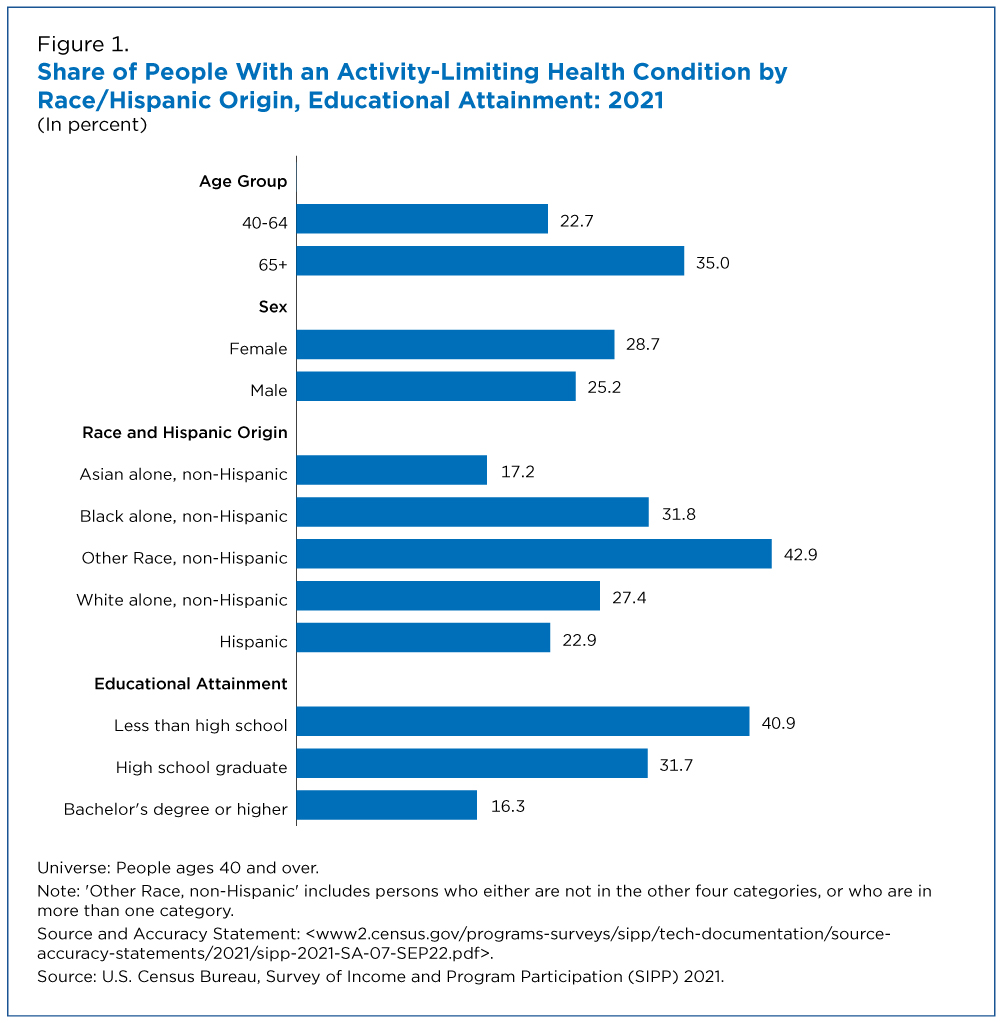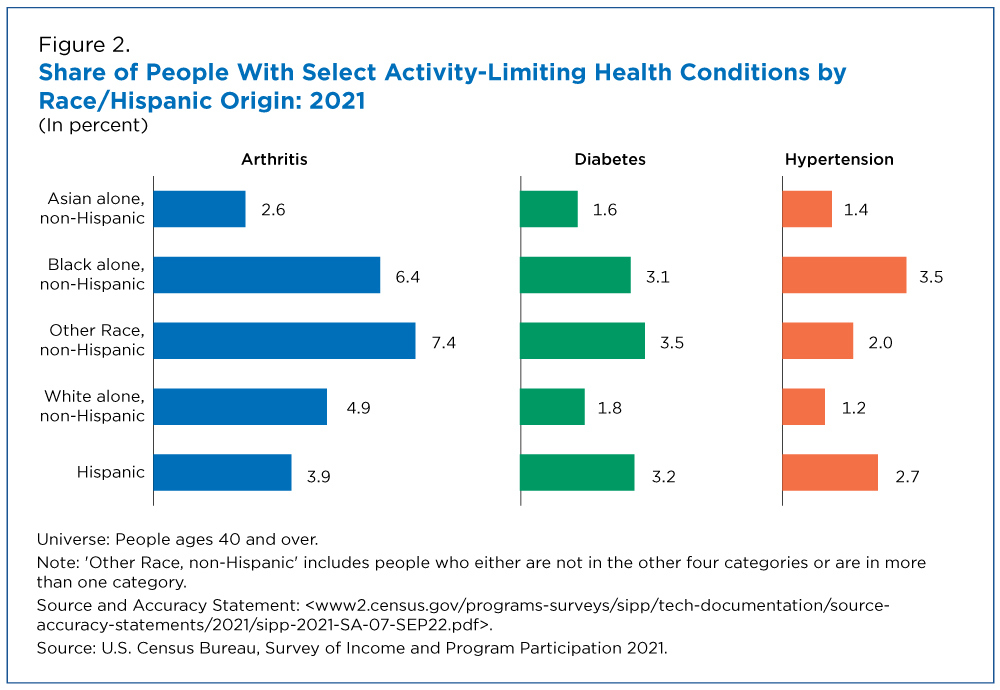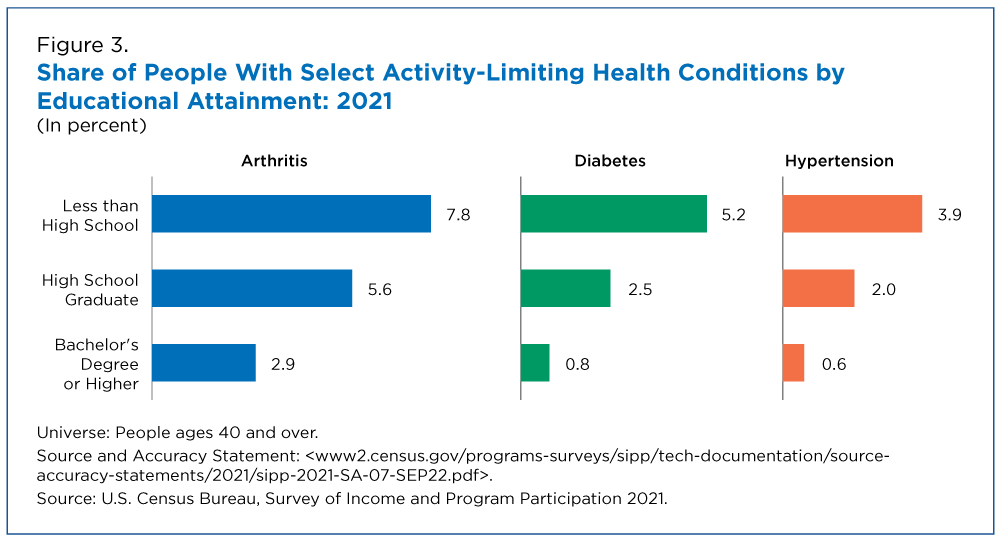Non-Hispanic Black Adults Have Higher Rates of Disability Due to Arthritis, Diabetes, Hypertension Than Non-Hispanic White Adults
Among adults ages 40 and older, non-Hispanic Asians reported the lowest rates of disability-related health conditions in 2021 while those in the non-Hispanic Black and Other race categories had the highest rates.
In 2021, the U.S. Census Bureau’s Survey of Income and Program Participation (SIPP) reintroduced questions on health conditions related to disability that can help us better understand the conditions that contribute to disability and how they vary by sex, race, ethnicity and education.
For example, disability-related hypertension was about three times as common among non-Hispanic Black adults (3.5%) than non-Hispanic White adults (1.2%).
SIPP measures disability using a standard series of six questions as well as questions about work disability and child disability. Beginning in 2021, it included an additional six questions capturing other functional difficulties: sitting, lifting, grasping, learning disability, mental/emotional condition, and any condition affecting functioning (for 12 months or longer).
Respondents who answered yes to any of these questions could report up to three health conditions that contributed to their disability.
Health-Related Disability by Sex, Race, Hispanic Origin
The data show patterns in health-related disability among adults age 40 and older and key differences by sex, race and Hispanic origin.
Among findings:
- Women were more likely than men to have health conditions that limited their daily activities (Figure 1).
- Asian (non-Hispanic) adults reported the lowest rates (17.2%) of disability-related health conditions.
- Black (non-Hispanic) adults (31.8%) and those reporting Other or multiple-race non-Hispanic identity (42.9%) were among those with higher rates.
Conditions That Contributed to Disability
The SIPP data provide insight into how health conditions contribute to disability. They do not provide prevalence estimates of health conditions within the population. Rather, these data tell us how often each condition is cited as a source of functional limitation among those reporting any type of disability.
For this analysis, we focused on three: arthritis, diabetes and hypertension (high blood pressure).
Some findings by race and ethnicity:
- Black (non-Hispanic) adults had significantly higher levels than non-Hispanic White adults of all three of these disability-related conditions (Figure 2). For example, disability-related hypertension was about three times as common among non-Hispanic Black adults (3.5%) than non-Hispanic White adults (1.2%).
- Hispanic individuals had higher levels of disability-related diabetes (3.2%) and hypertension (2.7%) and lower levels of arthritis (3.9%) than non-Hispanic White adults.
- Asian (non-Hispanic) respondents reported lower levels of arthritis than all other groups.
Education and Health Condition
These disability-related health conditions varied by educational attainment among adults age 40 and over: the higher the level of education, the lower the rates of all three health conditions (Figure 3).
Respondents with a high school diploma or GED were about twice as likely to have a disability-related condition (31.7%) as those with a bachelor’s degree or higher (16.3%).
Those who did not complete high school fared the worst: 40.9% reported a health condition contributing to disability – and diabetes and hypertension rates were both about six times higher among people who did not finish high school than among those with a bachelor’s degree or higher.
SIPP and Disability
This snapshot provides a glimpse of what SIPP data on disability and underlying health conditions can tell us about the well-being of the U.S. population.
The addition of these new variables in SIPP provides an opportunity to understand the interplay between health and disability. It also allows us to explore how health, disability and other facets of material well-being (such as employment, residential and economic stability) affect key populations over time.
About the SIPP
The SIPP is a nationally representative, longitudinal survey administered by the Census Bureau that provides comprehensive information on the dynamics of income, employment, household composition and government program participation.
The SIPP interviews individuals for several years and provides monthly data about changes in household and family composition and economic circumstances over time. More information is available at www.census.gov/sipp.
Related Statistics
Stats for Stories
Stats for Stories
Subscribe
Our email newsletter is sent out on the day we publish a story. Get an alert directly in your inbox to read, share and blog about our newest stories.
Contact our Public Information Office for media inquiries or interviews.









